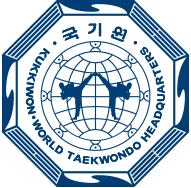Taekwondo players/fighters compete using full contact kicks and punches in a matted 8m x 8m square. Kicks are allowed to the body and head, while punches are only allowed to the body. More points are awarded for kicking to the head and/or spinning while doing so. Players wear pads, making Taekwondo one of the safest Olympic sports for injuries (according to a WTF report published after the London 2012 games).
More specific advice now follows for Taekwondo students wishing to compete for Stevenage Taekwondo:
What to Bring
On the day of the competition please ensure that your fingernails and toenails are trimmed short, players will not be allowed to fight if they have long or sharp nails.
Taekwondo players must wear WTF (and CE) approved equipment including a Taekwondo uniform (white collar for below 1st Dan/Poom, red/black or black for above) and belt, head guard, gum shield, reversible red/blue body protector, groin guard (worn under the uniform), forearm protectors, fist guards and shin guards. Foot protectors are optional. Make sure you bring all of these items with you.
All players must be fully insured members of a Taekwondo association (we are all members of the United Kingdom Taekwondo Development Council, itself a member of the British Taekwondo Council which is recognised by Sport England as the governing body for Taekwondo in the UK). Please check you are insured with sufficient time before and bring your licence with you.
Regardless of drinks brought for the day in general, please ensure you bring a bottle of water (either a sports bottle or a normal retail bottle with a sports lid). This may be needed during your fight and the coach won't bring one for you.
Food Before/During
All players should aim to have a low sugar, relatively light breakfast. This includes cereals (ideally high fibre ones for sustained energy) such as Weetabix, porridge, Shreddies, etc or toast (but without chocolate spread). Having a fried breakfast on the day of the competition is not a good idea.
We recommend bringing fruit and/or cereal bars as a good energy snack for between fights if needed. Don't bring chocolate or crisps (due to the insulin bounce as the body recovers from a high sugar intake).
We also recommend bringing a sealed container of pasta/rice (maybe mixed with tuna or chicken) for if there's a long gap between fights. Sometimes you may have two fights before, then the competition stops for a lunch break and it's straight back in to the next fight.
Players should aim not to eat a meal (breakfast or lunch) with less than an hour before fight time and shouldn't aim to stuff themselves at these meals.
After competition what the players eat is up to them, but something nice and tasty to celebrate their efforts/success is always good...
When You Arrive
The first thing is to get changed in to your uniform, with your groin guard underneath. Don't put on the rest of your pads yet, but do put on coat/hoodie/jumper (remember Club coats/hoodies with our logo are available) to keep warm.
The next step is to "weigh-in". Generally this is done in your uniform. If you are over the weight limit for your class, generally for children you can enter the class above or you can remove items (as far as modesty/parents allow, but no lower than underwear - behind a held up towel) at your discretion. Adults have no option normally, remove layers, go for a run in a sweat suit or be disqualified. For this weigh-in reason, we recommend after eating breakfast (an hour before arriving) the player keeps fluid intake low/minimal until after weigh-in.
Once you're weighed-in/entered, you can put on shin guards and forearm guards. If you want to wear fist protectors you can, but don't put on your body armour or head guard (or gumshield). Leave these last items until you're about to fight.
Then it's time to warm-up (if you're fighting in the morning). Start off by raising your body temperature, jogging/press-ups/etc. Then do joint rotations (head movement, shoulders, trunk twists, knee-up and outwards/inwards, etc). Finally on to leg swings in each direction. After this you can kick paddles to get your kicks moving.
After you're warmed up, if you are going back to rest while waiting for your fight, if you have loose jogging/track trousers, put them on over the top of your uniform/pads. This will help keep your muscles warm for longer. If you've had quite a delay (over an hour) then you might want to re-warm up with a lighter version at that point so you stay ready.
The Fight!
When your name is announced, you will be told a colour to wear and a ring to report to. At this point you should put your body armour on in the colour required and go with your coach to near the ring and notify an official you are there. Bring with you your head guard, gumshield and water bottle.
When it's time for you to fight, you will be called in with the command "chung-hong". Chung means blue and Hong means red. You then go to stand at the fighters points on the mat (the referee will be pointing to them) with your head guard under your arm and your gumshield in.
The first step is the referee will call you to attention with Cha-ryot and then ask you to bow to your opponent with Kyung-yeh. After this it's a nice sportsman-like custom to step to the side and bow to your opponents coach. The other player may not be aware of this custom, so don't show displeasure if they don't. Then come back in line to face them and put your head guard on.
The referee will then call Joon-bi to mean "ready" at which point you should go in to sparring stance with your arms raised in a sparring position and give a big loud shout. This clearly shows you are ready. Then the referee will announce shi-jack which means "begin". At this point the fight starts. If during the round the referee needs to stop the fight (a fighter has left the ring, the referee needs to award a penalty, etc) then he will announce Kal-yuh which means "break". After he's dealt with the situation he will announce kay-sock to mean "continue".
Valid points in Taekwondo are delivered with the front of the fist to body protector and with the part of the leg below the ankle bone to the body protector or any area above the collar bone (but not aiming for the back of the head). This is important, if you are too close and land with the shin it will not score. Strikes must be hard to the body and any level of contact to the head will score. Body kicks and punches are worth 1 point. If you spinning kick to the body (back kick or tornado kick) this is worth 2 points. If you kick to the head it's worth 3 points and a spinning kick to the head is worth 4 points. Some age divisions/competitions don't allow head kicks, so be aware of your division before doing them.
Referees can award half-point penalties or full point penalties. Odd half point penalties are ignored, but if you get two then they add up to a full point and your opponent is awarded an extra point. If you are awarded a full point penalty then your opponent gets an extra point. If you reach four penalty points in total then you are disqualified.
Half-point penalties are : Crossing the boundary line, Avoiding or delaying the match, Falling down (intentionally), Grabbing, holding or pushing the opponent, Attacking below the waist, Striking with the knee, Hitting the opponents head with the hand, Undesirable remarks or misconduct by player or coach, Lifting the knee to avoid/block an attack.
Full-point penalties are : Attacking the opponent after being given the break command, Attacking the fallen opponent, Throwing the opponent by grabbing or hooking the attacking foot in the air or by pushing the opponent with the hand, Intentionally attacking any part of the opponent's head with the hand, Intentionally attacking below the waist, A coach or a contestant interrupting the progress of the match, Violent or extreme remarks or behavior on the part of a contestant or a coach, Intentionally avoiding the match, Interfering with electronic scoring systems.
Note most of the full point penalties are the same as the half-point ones with "Intentionally" in there. This means an accidental kick below the waist will be penalised even if you didn't mean it. If you did mean it then it's a harsher penalty.
At the end of the round the referee will make a hand signal as if he's pushing you away. At this point, come back to your coach and sit down. Take deep slow breaths and listen carefully to the instructions your coach gives you for the next round. There often isn't time for much here, so the key things are - breath, drink (if needed) and listen. Then it's back in for the next round.
At the end of the fight, you will be called back to attention, remove your head guard, bow to your opponent and the referee will indicate the winner with "Chung-song" (blue-winner) or "Hong-song" (red-winner). At this point either congratulate your opponent on his winner or give him some positive comment on what he did well, a quick manly hug or shake his hand, go over to his coach, bow and shake his hand then come back to your coach. Well done, fight over!



